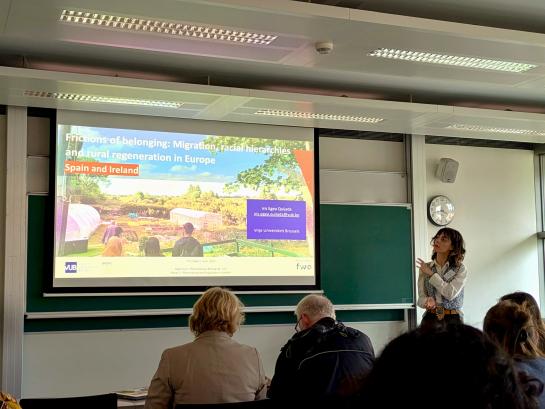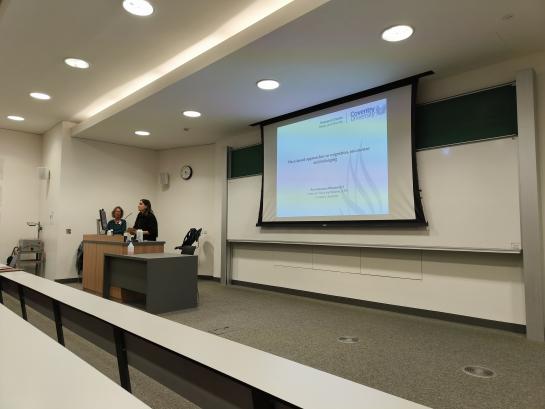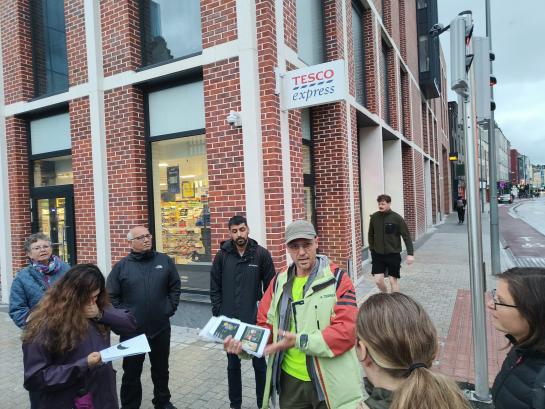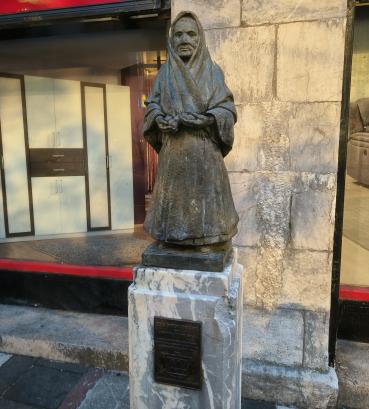11/06/2025, By Iris Egea Quijada
On Thursday and Friday, the 5th and 6th of June 2025, I participated in Cork’s ISS21 Migration and Integration Research Cluster. It focused on the theme Migration, Place/making, and Belonging. The event brought together international scholars and practitioners to explore key issues around the politics of place, belonging and exclusion, community-making, and conviviality.
This conference came at a particularly meaningful moment in my PhD journey, coinciding with my ethnographic fieldwork in Ireland. It provided a valuable platform for me to present my preliminary findings and take an initial step toward refining my comparative research on migration in Spain and Ireland. Presenting at the conference challenged me to think more deeply about how my two case studies inform and complement each other, prompting me to move toward a more nuanced and integrated analysis. The conference also offered rich and locally grounded feedback that I can now incorporate into the next phase of my research.

The opening by Dr. Caitríona Ní Laoire set the tone for a stimulating event, which featured inspiring keynote lectures by Professor Adrian Favell (University College Cork), Professor Susanne Wessendorf (Coventry University), Professor Maggie O'Neill (University College Cork), and Professor Parvati Nair (Queen Mary University of London). A particularly memorable element was a night tour of Cork that shed light on the often-overlooked lives of night workers—an experience that resonated powerfully with the conference’s broader theme of place-making and belonging.
In the following lines, I will share my reflections on the panel I participated in as well as highlight the moments from the conference that were most meaningful to me and that I found the most original for a conference setting.
Panel 2: Placemaking and migration in context
Chaired by Professor Ní Laoire, I had the opportunity to present my work-in-progress on racial frictions of belonging within rural regeneration frames. Together with three other scholars, we provided three complementary approaches to how place interacts with social relations and belonging in shaping migrant experiences.

Dr Vitalis Jafla Pontianus (UCC) perfectly set the stage for the issue at stake. He uncovered how the increasingly rigid and exclusionary policy-making practice in European migration regimes dangerously restricts migrant place-making. He called the European states as the original architects of the refugee regime to revisit their current backlash. The other three presentations were given by me, Dr. Emilia Pietka and Dr. Aurora Moxon and provided locally focused examples of practices and difficulties of place-making in rural contexts. Within the frame of depopulating rural settings, we elucidated the importance of social network access. In connection with socioeconomic factors, these shape the individual perceptions of a place and informing one’s mobility aspirations. Dr. Pietka, in her presentation on youth mobility in Scotland, challenged binary interpretations of mobility by illustrating it as a continuum—encompassing not just staying or leaving, but also returning. Her work underscored how young people's decisions are deeply intertwined with participants’ life stages, family relations, local opportunity structures and wider legal and socioeconomic status. Dr. Moxon contributed to challenging misleading perceptions that often label rural areas as backward, isolated spaces. By following the life stories of three goatherders in the Aspromonte Mountains, Southern Italy, she uncovered how herders build their sense of belonging through mobility within the region following their herds. These examples offer the potential for revaluing, maintaining and regenerating traditional jobs that are essential for the sustainability and livelihood of both rural and urban areas and the wider natural ecosystem (e.g., prevention of wildfires, maintenance of local languages and traditions) and their often-overlooked global connectivity. In my presentation, I brought forward the racial community tensions that arise in the pursuit of socioeconomic acceptance amid structural socioeconomic inequalities and racially excluding regimes.
Overall, this panel highlighted the key role that context—and the perception of such— plays in community-making or fragmentation within wider structural socioeconomic and racial systems. It underscored the opportunities of qualitative methodologies in thoroughly scrutinising place-making actions.
Plenary: place-based approaches to Migration, encounter and belonging – Susanne Wessendorf
Professor Wessendorf, who has conducted in-depth ethnographic fieldwork over long periods in complex urban settings, delivered the most inspiring and resonating keynote to my research. After engaging with different developments in place-making research, she used her two case studies of Mshongo and East London to discuss how symbolic boundaries shape interactions, perceptions of inequality, civility and reciprocity and how certain practices reinforce or soften boundaries. She highlighted the potential of bringing together the study of conviviality and symbolic boundaries to see how everyday practices of conviviality and neighbourly relations forge relations of trust that challenge the ever-present boundaries of belonging.

She concluded powerfully by outlining three favourable directions for future migration research. First, she uncovered the need for place-based approaches to study social relations and belonging in diverse areas to see how global and wider structures of racism and colonialism play out locally, why tensions arise and why certain groups are perceived as a problem. She highlighted that studying contexts where things work well can help us make change in places where things do not work so well. Second, she expressed the pressing need to question ethnicity and nationality as the most relevant categories of differentiation and the need to move away from approaches that inform policy that views immigration as a demographic threat that needs to be contained. She proposed to view the everyday realities of community coexistence. Finally, she emphasised the potential of marrying place-based approaches with research on migrant inclusion in shifting the responsibility away from individual migrants toward the arrival infrastructure of the receiving society.
Her thought-provoking speech did not leave anybody indifferent and encouraged fruitful and contested discussion over the opportunities and challenges of studying positive examples of conviviality. While some participants raised concerns about the creation of a utopian reality, Dr. Wessendorf’s proposal did not overlook the structural community conflicts and boundaries—as illustrated by the examples she shared during her presentation. Rather, it draws attention to the risks of allowing our work to be interpreted solely through a lens of tension and division, which can feed into increasingly polarised political discourses that seek to control and restrict human mobility. If we focus only on the negative, we risk overlooking the constructive potential of highlighting how things can be done differently in diverse contexts. Dr. Wessendorf’s suggestion is, in fact, well-founded in a reality where research informs policy, and where the language used by scholars often shapes governmental narratives and action.
Conference Nightwalk Tour of Cork City led by nocturnal anthropologist Dr Julius-Cezar Macarie

The night walk provided a well-rounded social activity for the theme of the conference, as showing place-making unfold in Cork city in front of our eyes. Following a conference dinner at the highly praised Palestinian Izz Café, nocturnal anthropologist Dr Julius-Cezar Macarie led an alternative tour of the city.
His walk spotlighted the often invisible night-time workforce—many of them migrants—including delivery drivers, club and bar staff, and street and market cleaners, whose essential labour sustains the city after dark. The tour also raised awareness of the role of women in the functioning of the city as well as Cork’s complex colonial legacy. This was illustrated through reflections on the enduring symbolism and social stratification represented by the English Market and the Irish Market. The experience was enriched by a reading from Dark Futures: When the Lights Go Down by Mick Dumm, a vivid and evocative account of night-time cityscapes. The walk concluded at the statue of The Onion Seller—Cork’s only statue of a woman—bringing overdue recognition to the historical contribution of female street traders known as the "Shawlies."
Final Reflections

Throughout the conference, participants not only challenged but also engaged in ways to move beyond the terminology around ‘migrant integration’, recognising it as a classed colonial political tool to categorise and classify foreign and or ‘minority’ populations against an unrealistic ‘majority’. There was a shared emphasis on the importance of intersectional approaches that account for temporality, place, and social positioning to more effectively capture migrant experiences and the processes of place-making among both migrant and host communities. Therefore, terms such as conviviality, uniqueness instead of difference, coexistence came to the fore.
The discussion highlighted the paradox inherent in today’s asylum and migration regimes, which expect the rapid ‘integration’ of newcomers while simultaneously placing structural and bureaucratic barriers in their way. This tension brings to light the challenges of temporality in asylum processes and underscores the need for a more nuanced understanding of time and transition in migration.
During the conference, presentations underscored the need to apply historical lenses for more critical and productive analyses of migration. Indeed, several historical moments—ranging from colonial legacies to more recent political shifts such as Brexit— have significantly shaped migrant place-making practices and senses of belonging. These dynamics unfold across different socioeconomic backgrounds and influence decisions around professional development, aspirations, and whether to settle or move elsewhere.
The conference also reaffirmed the value of place-based and intersectional approaches to understanding place-making and belonging. The rich qualitative component of many of the presentations—through the conduction of ethnographic fieldwork and participatory methods— proved that the sense of place is not fixed but fluidly shaped by gender, race, class, and mobility.
Personally, I had the valuable opportunity to exchange experiences with both early-career and more established scholars on the role of research positionality and the ways gender dynamics unfold in the field. These exchanges became powerful moments of mutual learning, understanding and empowerment. This made me reflect on the need to create more open, safe, and collaborative spaces such as the one fostered throughout this conference, where diverse researchers can freely empathise with each other. Research positionality is something that we, as researchers, are continually confronted with, but do not always have the means, knowledge or courage to address it carefully. Spaces like this remind us of the value of sharing, listening, and supporting one another as we navigate these complexities together.
